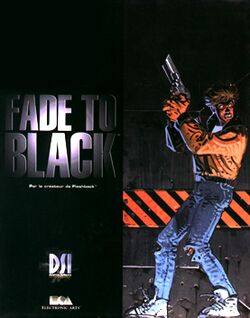Software:Fade to Black (video game)
| Fade to Black | |
|---|---|
 Cover art drawn by Jean Giraud | |
| Developer(s) | Delphine Software International |
| Publisher(s) |
|
| Director(s) | Paul Cuisset |
| Designer(s) | Paul Cuisset |
| Programmer(s) |
|
| Artist(s) | Thierry Perreau |
| Composer(s) | Raphaël Gesqua |
| Platform(s) | MS-DOS, PlayStation, Dreamcast |
| Release | |
| Genre(s) | Action-adventure |
| Mode(s) | Single-player |
Fade to Black is a 1995 action-adventure game developed by Delphine Software International and published by Electronic Arts. It is the sequel to the 1992 video game Flashback. The game was released for MS-DOS with full Gouraud-shaded 3D graphics, and PlayStation with fully textured 3D. A version for the Dreamcast was released in 2018 by JoshProd, rebranded as Fade to Black: Flashback 2.
Gameplay
Fade to Black is a 3D action-adventure game with a third-person view from behind the character's back. It features gun combat with a number of platforming sequences.
Plot
The main protagonist is Conrad Hart who, in Flashback, destroyed the planet of hostile aliens called the Morphs and went into suspended animation in a spaceship that floats aimlessly through outer space. In the year 2190 (50 years later), he is found by the Morphs and imprisoned in the Lunar prison of New Alcatraz. There, he is rescued by a man who introduces himself as John O'Conner, who tells him that the Morphs beat him to Conrad's ship, and leaves Conrad a few items "of interest" (a PDA and a handgun), before destroying the camera. On the PDA is a message from John, who tells Conrad to sneak around the base. Mandragore agents left a radar scrambler there. Conrad soon makes it to John's ship. As they blast off, Morph ships start attacking them. They teleport to Mandragore base Shadow just as the ship is destroyed.
They meet Sarah Smith, the leader of the Mandragore resistance. Later, in a meeting with Mandragore commander Hank, she tells Conrad that while he was in suspended animation the Morphs attacked Earth with superior forces, which made the governments surrender. The Mandragore has far fewer people, but they refuse to give up. Agents then call Sarah and tell her that they have found the location of Professor Bergstein: Morph asteroid base D321. Sarah sends Conrad and John there to rescue him. Conrad eventually finds Bergstein, who tells him that the base must be destroyed because it contains the Morph's new mind-manipulating weapon. He gives him a datacube (similar to the holocube that is in Flashback), which he explains contains a virus that he programmed in. The virus will blow up the base when the datacube is connected to the core. They connect the virus to the core and escape the base with John as it blows up, along with the asteroid itself.
Conrad is then sent to a mining facility on Mars and gets the coordinates to a Morph base, where he rescues and meets Ageer. He tells Ageer about his previous adventures. Ageer tells Conrad that he and his people, an ancient alien race referred to as the "Ancients", want to join the Mandragore and can lead them to victory. Soon, Ageer tells Conrad that he must find the oracle in Pluto, the homeland of the Ancients. Conrad travels to Pluto with Ageer, who then tells Conrad that the oracle will lead him to the pyramid. As he travels, he finds a glass eyeball that he gives to a hand creature that then gives him the oracle. The oracle does lead Conrad to the pyramid, which Ageer uses to give the history of the Ancients to Conrad: "The Ancients live in peace until the Morphs arrive. The Ancients think that they come in peace and they welcome them. However, the Morphs attack the ancients. The Ancients put their souls in the pyramid, which is then captured by the Morphs."
A Morph spaceship arrives to Pluto to stole the pyramid and take it to a Morph base, while a new and apparently invincible creature, the Super Morph, also arrives to kill Conrad. After avoiding him, he is teleported by Ageer to the Morph base in which he makes through looking for the stolen pyramid. In the meantime, he sees John telling Master Brain that their plan has become a success; with his identity, he has managed to infiltrate Shadow and put in an active detonation device. Master Brain tells John that someone is spying on them. John looks back, sees Conrad, and then transforms into his true identity: the Super Morph. After avoiding him, Conrad quickly takes the pyramid with the Morph spaceship and returns to Shadow, which is then attacked by the Morphs. Conrad fights his way through the Morphs as agents get killed. Conrad gets a key from a rescued soldier, which gives him access to the command room, where Conrad meets Hank. He tells Conrad that Sarah can give him the code to disable the detonation device, but she has been taken hostage by a Morph. Conrad gets to the floor and saves Sarah, who then gives him the code and teleports away.
After Conrad disables the device, Ageer and Hank enter the command room as Sarah explains their new plan. The Ancients have given the Mandragore the ability to know where the Master Brain controlling the solar system is on Easter Island in planet Earth. She and Conrad will teleport there and destroy it. As they arrive, they separate. Conrad eventually teleports to the Master Brain and throws the pyramid in front of it. As he then teleports away, the pyramid fights and defeats the Master Brain. As Conrad flees Easter Island, it starts exploding, and the Super Morph gives chase.
There are two endings: one in which Conrad rescues Sarah from the Super Morph and a second ending where Conrad escapes alone. In both endings, the Super Morph is killed by the turbines of the escaping spaceship. But in the second ending, as a consequence of Conrad having to pilot the spaceship instead of Sarah, players are forced to complete a difficult flight sequence before the final cinematic.
Development
Shortly after the release of Flashback in 1992, the development team started work on a similar sequel titled Morphs: Flashback 2 for the Sega CD. Work on the game spanned 3-4 months, however, the project was put on hold while they focused on finishing Shaq Fu (1994). By the time they returned to the project, the Sega CD was no longer seen as a viable platform, so it was scrapped in favor of restarting on PC, which turned into the 3D shooter Fade to Black[1] The idea of doing a 3D sequel to Flashback started in 1993.[2] The game was originally announced under the title "Crossfire".[3]
Conrad's animations were created using motion capture.[3]
Reception
| Reception | ||||||||||||
|---|---|---|---|---|---|---|---|---|---|---|---|---|
| ||||||||||||
| ||||||||||||
The PlayStation version was a best-seller in the United Kingdom,[9] where it was among the nineteen best-selling PlayStation games of 1996 according to HMV.[10] It sold enough copies to go Platinum.
Fade to Black received a moderately positive critical response.[11] Electronic Gaming Monthly gave the PlayStation version their "Game of the Month" award.[4] Reviewers generally criticized the game's steep difficulty[4][5][12] and blocky polygon models,[4][12] but praised the background graphics and animations,[4][12] and generally concluded that the game's close blend of action and puzzling in a 3D environment was a success.[4][5][12]
Fade to Black was named the 29th best computer game ever by PC Gamer UK in 1997. The editors called it "an adrenaline-pumping polygon adventure" and "an intriguing game".[13] In 1996, GamesMaster ranked the Playstation version 50th on their "Top 100 Games of All Time."[14]
Cancelled sequel
Flashback Legend was an unfinished second sequel of Flashback. It was in co-development by Delphine Software International and Adeline Software International for a planned release in 2003. As opposed to Fade to Black, it was going to be a 2D side-scroller game, like Flashback, but without non-scrolling areas. It was targeted exclusively for the Game Boy Advance.[15] The game was cancelled when Delphine went bankrupt and ceased operations in the end of 2002. However, a prototype ROM, dated 21 June 2002, was leaked and spread over the Internet at some point. It features all 16 levels with minor glitches and one music track, which is a compressed tune from Fade to Black. Despite multi-language options the beta can only be played in French with an English pause menu, but can be played in English via a fan-made patch.[15]
References
- ↑ "Bozocircus v3.0". http://www.bozocircus.free.fr/f_fb2.php.
- ↑ "Caught in the Crossfire". Next Generation (Imagine Media) (6): 63. June 1995.
- ↑ 3.0 3.1 "Crossfire". Next Generation (Imagine Media) (6): 59–62. June 1995.
- ↑ 4.0 4.1 4.2 4.3 4.4 4.5 "Review Crew: Fade to Black". Electronic Gaming Monthly (Ziff Davis) (84): 22. July 1996.
- ↑ 5.0 5.1 5.2 "Knockout". Next Generation (Imagine Media) (21): 148. September 1996.
- ↑ 6.0 6.1 Klett, Steve (November 1995). "Fade to Black". PC Games. http://www.pcgamesmag.com:80/games/Nov95/fade1195.html. Retrieved August 15, 2019.
- ↑ Michael L. House. "Fade to Black (PlayStation) Review". http://www.allgame.com/game.php?id=2109&tab=review.
- ↑ Michael L. House. "Fade to Black (PC) Review". http://www.allgame.com/game.php?id=5549&tab=review.
- ↑ Gallup UK Playstation sales chart, September 1996, published in the Official UK PlayStation Magazine issue 10
- ↑ "Editorial". Computer and Video Games (United Kingdom: EMAP) (183 (February 1997)): 6–7. 10 January 1997. https://archive.org/details/Computer_and_Video_Games_Issue_183_1997-02_EMAP_Images_GB/page/n5/mode/2up.
- ↑ Fade to Black at GameRankings
- ↑ 12.0 12.1 12.2 12.3 "ProReview: Fade to Black". GamePro (IDG) (96): 66. September 1996.
- ↑ Flynn, James; Owen, Steve; Pierce, Matthew; Davis, Jonathan; Longhurst, Richard (July 1997). "The PC Gamer Top 100". PC Gamer UK (45): 51–83.
- ↑ "Top 100 Games of All Time". GamesMaster (44): 76. July 1996. https://retrocdn.net/images/c/cf/GamesMaster_UK_044.pdf.
- ↑ 15.0 15.1 Flashback Legends at Unseen64
External links
- Short description: Video game database
 Logo since March 2014 | |
Screenshot  Frontpage as of April 2012[update] | |
Type of site | Gaming |
|---|---|
| Available in | English |
| Owner | Atari SA |
| Website | mobygames |
| Commercial | Yes |
| Registration | Optional |
| Launched | January 30, 1999 |
| Current status | Online |
MobyGames is a commercial website that catalogs information on video games and the people and companies behind them via crowdsourcing. This includes nearly 300,000 games for hundreds of platforms.[1] The site is supported by banner ads and a small number of people paying to become patrons.[2] Founded in 1999, ownership of the site has changed hands several times. It is currently owned by Atari SA.
Content
The database began with games for IBM PC compatibles. After two years, consoles such as the PlayStation, were added. Older console systems were added later. Support for arcade video games was added in January 2014 and mainframe computer games in June 2017.[3]
Edits and submissions go through a leisurely verification process by volunteer "approvers". The approval process can range from immediate (minutes) to gradual (days or months).[4] The most commonly used sources are the video game's website, packaging, and credit screens. There is a published standard for game information and copyediting.[5]
Registered users can rate and review any video game. Users can create private or public "have" and "want" lists which can generate a list of games available for trade with other registered users. The site contains an integrated forum. Each listed game can have its own subforum.
History

MobyGames was founded on March 1, 1999 by Jim Leonard and Brian Hirt, then joined by David Berk 18 months later, three friends since high school.[6] Leonard had the idea of sharing information about computer games with a larger audience.
In mid-2010, MobyGames was purchased by GameFly for an undisclosed amount.[7] This was announced to the community post factum and a few major contributors left, refusing to do volunteer work for a commercial website.
On December 18, 2013, MobyGames was acquired by Jeremiah Freyholtz, owner of Blue Flame Labs (a San-Francisco-based game and web development company) and VGBoxArt (a site for fan-made video game box art).[8] Blue Flame Labs reverted MobyGames' interface to its pre-overhaul look and feel.[9]
On November 24, 2021, Atari SA announced a potential deal with Blue Flame Labs to purchase MobyGames for $1.5 million.[10] The purchase was completed on 8 March 2022, with Freyholtz remaining as general manager.[11][12]
See also
- IGDB – game database used by Twitch for its search and discovery functions
References
- ↑ "MobyGames Stats". https://www.mobygames.com/moby_stats.
- ↑ "MobyGames Patrons". http://www.mobygames.com/info/patrons.
- ↑ "New(ish!) on MobyGames – the Mainframe platform.". Blue Flame Labs. 18 June 2017. http://www.mobygames.com/forums/dga,2/dgb,3/dgm,237200/.
- ↑ "MobyGames FAQ: Emails Answered § When will my submission be approved?". Blue Flame Labs. 30 March 2014. http://www.mobygames.com/info/faq7#g1.
- ↑ "The MobyGames Standards and Practices". Blue Flame Labs. 6 January 2016. http://www.mobygames.com/info/standards.
- ↑ "20 Years of MobyGames" (in en). 2019-02-28. https://trixter.oldskool.org/2019/02/28/20-years-of-mobygames/.
- ↑ "Report: MobyGames Acquired By GameFly Media". Gamasutra. 2011-02-07. http://www.gamasutra.com/view/news/32856/Report_MobyGames_Acquired_By_GameFly_Media.php.
- ↑ Corriea, Alexa Ray (December 31, 2013). "MobyGames purchased from GameFly, improvements planned". http://www.polygon.com/2013/12/31/5261414/mobygames-purchased-from-gamefly-improvements-planned.
- ↑ Wawro, Alex (31 December 2013). "Game dev database MobyGames getting some TLC under new owner". Gamasutra. http://www.gamasutra.com/view/news/207882/Game_dev_database_MobyGames_getting_some_TLC_under_new_owner.php.
- ↑ "Atari invests in Anstream, may buy MobyGames". https://www.gamesindustry.biz/articles/2021-11-24-atari-invests-in-anstream-may-buy-mobygames.
- ↑ "Atari Completes MobyGames Acquisition, Details Plans for the Site’s Continued Support". March 8, 2022. https://www.atari.com/atari-completes-mobygames-acquisition-details-plans-for-the-sites-continued-support/.
- ↑ "Atari has acquired game database MobyGames for $1.5 million" (in en-GB). 2022-03-09. https://www.videogameschronicle.com/news/atari-has-acquired-game-database-mobygames-for-1-5-million/.
Wikidata has the property:
|
External links
 |
Warning: Default sort key "Fade To Black (Video Game)" overrides earlier default sort key "Mobygames".
 |
